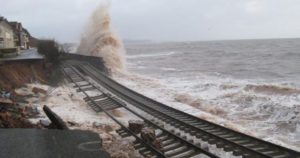Our fifth rail decarbonisation blog comes from Dr Andrew Quinn who explains where climate change and railway resilience fit into the decarbonising agenda. Thanks go to Rachel Fisher for her contributions.

You may remember the dramatic image of suspended railway track after the supporting structure was washed away in February 2014 along the infamous Dawlish sea wall. A combination of stormy seas and high tides led to the structure being washed away, leaving the track hanging, whilst the sea continued to erode what was left of the substructure. This cost the railway industry somewhere in the region of £45 million and caused the line to be closed for some months, which had a big impact on communities in the south western region of the UK.
Extreme weather events of many types regularly affect railway infrastructure and the provision of train services across the UK. Events such as flooding, lightning strikes, high temperatures and the “wrong kind of snow” cause disruption on the network all year round. Sadly, the latest scientific data, collated and reviewed by the Intergovernmental Panel on Climate Change, highlight that the increasing frequency of such events is the first and most visible sign of our changing global climate. If the UK is due to have hotter, drier summers and warmer, wetter winters in the future how will this affect the railway network and how can we adapt to these changes? These are the two key questions we explore at BCRRE in our research investigating and improving the resilience of railway networks to weather and climate change.
So, what is resilience? Broadly speaking, it is the ability of a system (in this case the railway network) to reliably resist and recover from the effects of external disrupting factors (in this case weather and climate change). This might include having sufficient redundancy to absorb the impact and recover quickly, resuming normal operations; or being able to reroute and redeploy workers and equipment to make repairs wherever required. We split this into two aspects, physical resilience and operational resilience.
The physical resilience of rail infrastructure is a topic that we have been investigating for over 10 years. By improving our understanding of the effects of extreme weather on rail infrastructure we can begin to develop ways of redesigning and adapting the railways to resist the impact of weather, creating reliable railway infrastructure for the future. We have been part of major projects such as TRaCCA, investigating the risks associated with extreme weather events and climate change and the impact these will have on our railway networks in the future. By improving the understanding of these, and engaging with stakeholders in the rail industry, we were able to develop a comprehensive adaptation framework through the Rail Adapt project, to support the rail industry in improving their processes for adapting its infrastructure to be resilient under future climates. We have expanded upon this work in the new SIRMA [Strengthening Infrastructure Risk Management in the Atlantic Area] project to develop risk models, mitigation, and resilience-based decision support tools utilising a systems of systems approach to ensure that transport infrastructure along Atlantic coastlines is resilient under future climates to a variety of fast acting (e.g. storm) and slow-acting (e.g. corrosion) hazards. This is crucial to the continued socio-economic development in coastal regions.
We have also investigated the operational resilience of train services in the UK, particularly by investigating delay propagations. If one train is affected by one incident and is delayed, this can affect the whole network. For example, in this video, a flooding delay at Barnt Green station, servicing a village in the West Midlands, can be seen to propagate across GB and eventually impacts train services as far away as Penzance and Glasgow and for over 10 hours since the incident happened.
Through the FUTURENET project we developed new ways to quantify this resilience and further work has identified those critical locations on the railway network. These are locations where incidents cause the biggest impact on train operations across the country: so identifying them means that they may be protected or prioritised, and the impact of weather reduced.
Through the other streams of work within the new Centre of Excellence for Rail Decarbonisation at BCRRE, we hope to play our role in reducing the carbon emissions from the transport sector and therefore help mitigate the scale of the change in the climate. In doing so, it is hoped that the impact on national transport infrastructure such as the railways will also be reduced through smart adaptation. However, the climate is already changing and we must create a resilient railway network to ensure carbon neutral, accessible, future mobility.
Read more about Andrew’s work and that of his researchers on our website and contact him directly on email.
